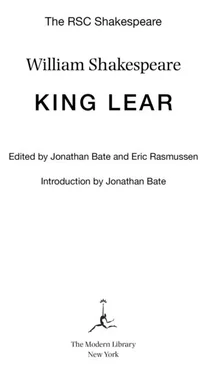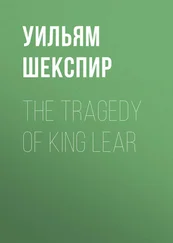уильям шекспир - King Lear
Здесь есть возможность читать онлайн «уильям шекспир - King Lear» весь текст электронной книги совершенно бесплатно (целиком полную версию без сокращений). В некоторых случаях можно слушать аудио, скачать через торрент в формате fb2 и присутствует краткое содержание. Год выпуска: 2011, ISBN: 2011, Издательство: Random House Publishing Group, Жанр: Старинная литература, на английском языке. Описание произведения, (предисловие) а так же отзывы посетителей доступны на портале библиотеки ЛибКат.
- Название:King Lear
- Автор:
- Издательство:Random House Publishing Group
- Жанр:
- Год:2011
- ISBN:978-1-58836-828-7
- Рейтинг книги:3 / 5. Голосов: 1
-
Избранное:Добавить в избранное
- Отзывы:
-
Ваша оценка:
- 60
- 1
- 2
- 3
- 4
- 5
King Lear: краткое содержание, описание и аннотация
Предлагаем к чтению аннотацию, описание, краткое содержание или предисловие (зависит от того, что написал сам автор книги «King Lear»). Если вы не нашли необходимую информацию о книге — напишите в комментариях, мы постараемся отыскать её.
King Lear — читать онлайн бесплатно полную книгу (весь текст) целиком
Ниже представлен текст книги, разбитый по страницам. Система сохранения места последней прочитанной страницы, позволяет с удобством читать онлайн бесплатно книгу «King Lear», без необходимости каждый раз заново искать на чём Вы остановились. Поставьте закладку, и сможете в любой момент перейти на страницу, на которой закончили чтение.
Интервал:
Закладка:
Fools and Madmen
Real and assumed madness play an essential part in the plot of King Lear . In a program note by Michael MacDonald, author of a historical study called Mystical Bedlam: Madness, Anxiety and Healing in Seventeenth Century England (1983), Adrian Noble’s 1993 production was contextualized by means of the suggestion that the audience
is presented with three kinds of madness: real in Lear himself, assumed in Tom/Edgar, and professional in the Fool. To its original audience, in a population largely uneducated, unable to distinguish between epilepsy, demonic possession and a skilful beggar on the make, the spectacle of an old man and a half-naked creature railing at the weather and babbling about demons would not have been especially unusual: like the unemployed and other vagrants the countryside teemed with, they were a fact of life. 34
Lear is very rarely played as being driven mad exclusively by the cruelty that is inflicted on him, but is often portrayed as being dangerously unhinged from the start. In Nicholas Hytner’s production,
the early household scenes are honeycombed with … micro-sequences, which take you inside Lear’s head, showing his hunger for affection, his need to play the strong man, his short attention span, and his helpless descents into blind rage. These are an embarrassment to the court and they give the sisters every pretext for saying something to keep the old man happy. But it is only when they try to draw the line that you really see what they have had to put up with. At the suggestion that he should shed a few knights, all hell breaks loose in the Albany dining room, with Lear emptying his gun into the ceiling, crushing Goneril to the ground like a blubbering child, clearing the space for carnage by hanging the Fool on a coat-hook: and finally vanishing into the night leaving his shaken hosts facing each other down a long table for their solitary dinner. 35
Very clearly a man with no control over his own emotions, John Wood’s Lear was also an emotional vandal to his daughters, and his influence could be seen in their learned behavior.
In Buzz Goodbody’s 1974 production, to be a sane man in a cruel world was to be part of that cruelty. Lear’s madness became the transitional stage from cruelty to humanity:
Tony Church did not play Lear as a virtuoso acting part, but as a down-to-earth king, a patriarch who got his pleasure from hunting. He is out in the cold because of who he is—not a mighty monarch fallen from grace, but an old man on the point of death, facing himself and his life.… When he is “sane,” he represents the cruel world, arbitrary and aggressive, and only when he is “mad” does he embody human values. 36
In the stunning visual sequence that started Adrian Noble’s 1982 production, lunacy not only led to virtue but was linked to it through the characters of the Fool and Cordelia:
On Lear’s throne the Grock-like Fool and Cordelia sit facing each other, with their necks at opposite ends of a taut halter (resembling a noose), as if lunacy and virtue were inseparable.… What follows is a delirious descent into a world of barbarism in which farce and tragedy are umbilically linked. 37
Antony Sher played the Fool as “Lear’s alter-ego, the visible mark of his insanity. His Master’s Voice as he perches on his lap like a ventriloquist’s doll, the conscience of the King.” 38In the words of the reviewer in the Jewish Chronicle , “There is a strong sense in which, just as the great comic double acts are like watching a schizophrenic trying to pull himself together, Antony Sher’s red-nosed clown and Michael Gambon’s violent old man are two warring parts of one psyche.” 39The poet and critic James Fenton, writing in the London Sunday Times , pushed the point further:
Michael Gambon’s Lear was a man all too willing to cast off his role as king, and his relationship to the Fool pointed to this uneasiness.
Lear’s foolishness and his love for his Fool are the points of departure for the interpretation. In all his madness, his anger and his suffering, we do not forget this. Indeed, I wonder if Lear has ever fooled around so enthusiastically.
Imagine a production in which the King, though condemned to kingship, would clearly love to have been a comedian, while the Fool, although unable to stop jesting, is transfixed by the horror of his true perception of the tragedy. This is the version which Adrian Noble has directed.… This is not the Fool of criticism, not an A-level “assess-the significance-of-the-Fool” fool. This is your genuine professional fool. Inside whom is a man in a panic, the Cassandra of the play, whose raving prophesies terrify the prophet himself. 40
Sher described how in rehearsals they came up with a solution to the disappearance of the Fool after the arrival of Tom o’Bedlam. 41During the mock trial scene the Fool picked up a pillow to represent Regan. On the words “anatomize her,” Lear stabbed the pillow in a frenzy of rage. In his insane and violent outburst he fatally stabbed the Fool accidentally. With all the attention on Lear leaving the hovel, the others did not realize what had happened. The Fool slumped down dead into a barrel in which he stood.
The emphasis put on the Fool in this production (the program cover featured a fool’s face with a red nose that appeared to be an amalgam of Lear and the Fool), along with Sher’s magnificent performance, led many critics to feel that the play became unbalanced, losing impetus in the final acts after the Fool was killed.
At the end of the hovel scene Edgar has replaced the Fool as Lear’s spiritual mentor. Lear takes Edgar off in one direction as the Fool exits in another. According to director Adrian Noble,
That happens accidentally. He doesn’t plan that.… For some reason he decides to take on the sins of others … in exactly the same way as a pilgrim, monk or nun … dedicate their lives in a particular way that enables other people to have a richer spiritual life. It is a gift of humanity to God. This is exactly the same thing with Edgar. 42
Lear’s journey into his own fooldom takes him from the enclosed mental space of the court out into the world and the secrets of humanity, to emotions denied and hidden from him by dint of his position in society. This awakening by the Fool and Poor Tom leads to a political and spiritual epiphany that is life-changing and possibly world-changing. Many directors have seen the following lines—often quoted in their program notes—as the core of the play:
Poor naked wretches, wheresoe’er you are,
That bide the pelting of this pitiless storm,
How shall your houseless heads and unfed sides,
Your lopped and windowed raggedness, defend you
From seasons such as these? O, I have ta’en
Too little care of this! Take physic, pomp,
Expose thyself to feel what wretches feel,
That thou mayst shake the superflux to them
And show the heavens more just.
The political dimensions of King Lear are most clearly evidenced in the king’s interaction with the mad beggar. Edgar, the abused son, and Poor Tom, the forgotten citizen of Lear’s England, embody both familial and national neglect. Edgar’s disguise as Bedlam beggar is also crucial to Lear’s spiritual journey. In Noble’s second production of the play for the RSC in 1993:
[Lear’s] growing obsession with this emblem of “unaccommodated man” causes the displacement of the Fool … was brilliantly visualized in the image of Ian Hughes clinging forlornly to Poor Tom’s hand at the end of a human chain that Gloucester led across the stage. 43
Visually Edgar has variously appeared as a Caliban-type figure, the poor bare-forked animal spouting obscenities but in need of the world’s pity, as Christ-like with a crown of thorns, bloodied and suffering for the world’s sins, or alternatively as demonic, as in the RSC’s 1982 production when “Jonathan Hyde’s Edgar as a virtually naked Poor Tom [burst] through the splintering floor like some infernal demon born on to Lear’s ‘great stage of fools’.” 44“It was the modern equivalent of the entrance of a devil from the pit of Hell, and Tom’s demonic side, which actors so often miss as they go for shivering pathos, was established at once.” 45
Читать дальшеИнтервал:
Закладка:
Похожие книги на «King Lear»
Представляем Вашему вниманию похожие книги на «King Lear» списком для выбора. Мы отобрали схожую по названию и смыслу литературу в надежде предоставить читателям больше вариантов отыскать новые, интересные, ещё непрочитанные произведения.
Обсуждение, отзывы о книге «King Lear» и просто собственные мнения читателей. Оставьте ваши комментарии, напишите, что Вы думаете о произведении, его смысле или главных героях. Укажите что конкретно понравилось, а что нет, и почему Вы так считаете.












